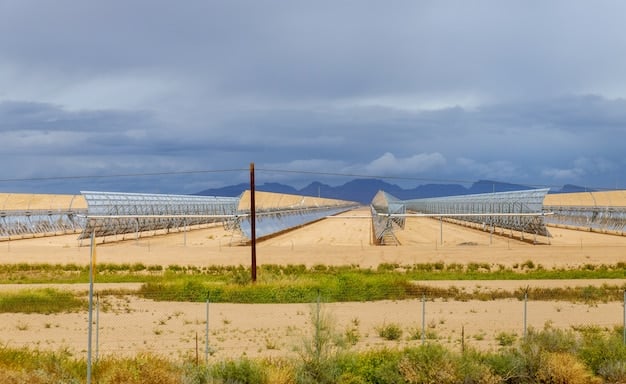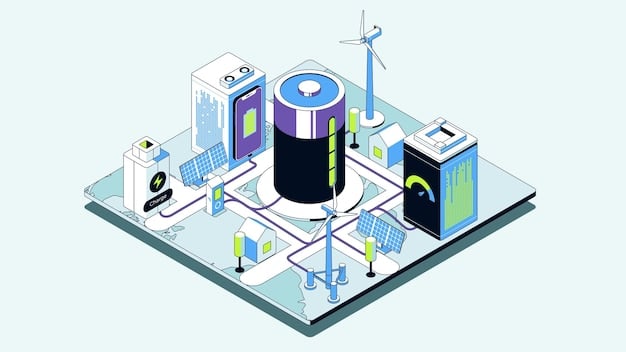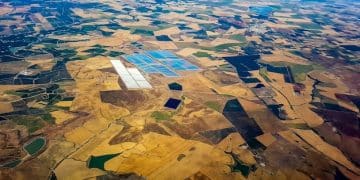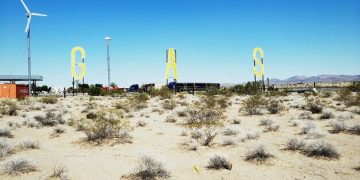The Future of Renewable Energy: Predictions for the Next Decade

The Future of Renewable Energy: Predictions for the Next Decade anticipates a surge in solar and wind capacity, advancements in energy storage, and policy shifts driving sustainable growth, but uncertainties remain regarding technological breakthroughs and global cooperation.
The world is rapidly shifting towards sustainable energy solutions, and understanding the **future of renewable energy: predictions for the next decade** is crucial for investors, policymakers, and environmentally conscious citizens alike. Let’s explore what the next ten years hold for this transformative sector.
Renewable energy sources: Current landscape
Renewable energy has experienced significant growth in recent years, driven by concerns about climate change, energy security, and decreasing costs. Solar, wind, hydro, and geothermal energy sources are becoming increasingly competitive with fossil fuels.
Current trends indicate a continued expansion of renewable energy capacity worldwide, with many countries setting ambitious targets for decarbonization. However, challenges remain in terms of grid integration, energy storage, and policy support.
Solar energy: A shining star
Solar energy has seen dramatic cost reductions, making it one of the most affordable renewable energy sources. Technological advancements, such as improved panel efficiency and energy storage solutions, are further boosting its appeal.
- Increased adoption of distributed solar power systems, including rooftop solar panels for homes and businesses.
- Development of large-scale solar farms in sunny regions, contributing significantly to grid electricity.
- Advancements in solar panel technology, such as perovskite cells and bifacial panels, are further enhancing efficiency.

Wind power: Harnessing the breeze
Wind power is another rapidly growing renewable energy source, with onshore and offshore wind farms becoming increasingly common. Technological improvements, such as larger turbines and improved grid integration, are enhancing its competitiveness.
- Expansion of offshore wind farms, which offer higher capacity factors and less visual impact compared to onshore wind farms.
- Development of taller and more efficient wind turbines, capable of capturing more wind energy.
- Improved grid infrastructure to integrate wind power into the electricity grid more effectively.
Renewable energy sources are currently transforming the global energy landscape, with solar and wind leading the charge. Continued innovation and policy support will be crucial for realizing their full potential and achieving a sustainable energy future.
Predictions for solar energy in the next decade
Solar energy is poised for continued expansion in the next decade, driven by decreasing costs, technological advancements, and supportive policies. The following predictions outline the key trends and developments expected in the solar energy sector.
From efficiency upgrades to integration of storage solutions, solar energy is set to revolutionize how we generate and use electricity. The next decade promises remarkable changes.
Increased efficiency and reduced costs
Solar panel efficiency is expected to continue to improve, with new materials and designs pushing the boundaries of what is possible. Perovskite solar cells, for example, could offer significantly higher efficiencies than traditional silicon-based panels.
Moreover, economies of scale and manufacturing innovations are expected to further reduce the cost of solar energy. This will make solar power even more competitive with fossil fuels, attracting more investors and consumers.
Integration with energy storage solutions
One of the major challenges for solar energy is its intermittency, as sunlight is not always available. To address this, solar energy systems are increasingly being integrated with energy storage solutions, such as batteries.
Lithium-ion batteries are currently the most common energy storage technology, but other technologies, such as flow batteries and solid-state batteries, are also being developed. These batteries can store excess solar energy generated during the day and release it when needed, providing a more reliable and consistent power supply.
Solar energy’s continued growth in the next decade will be shaped by cost reductions, efficiency improvements, and the integration of energy storage. These trends will solidify its place as a crucial component of the global energy transition.
The future of wind energy: What to expect
Wind energy is also expected to grow significantly in the next decade, driven by technological advancements, supportive policies, and increasing demand for clean energy. The following predictions highlight the key trends and developments in the wind energy sector.
With larger turbines, offshore expansion, and enhanced grid integration, wind energy is set to play a pivotal role in powering our future. Let’s explore the key developments.
Larger and more efficient wind turbines
Wind turbine technology is constantly evolving, with manufacturers developing larger and more efficient turbines. Taller turbines can capture more wind energy, while improved blade designs enhance energy conversion efficiency.

These advancements are making wind power more cost-effective and competitive with other energy sources, fostering greater adoption and investment.
Offshore wind expansion
Offshore wind farms offer several advantages compared to onshore wind farms, including higher capacity factors and less visual impact. As a result, offshore wind is expected to experience significant growth in the next decade.
Many countries are investing heavily in offshore wind projects, particularly in regions with strong wind resources. Technological advancements, such as floating wind turbines, are also opening up new possibilities for offshore wind development in deeper waters.
Wind energy’s trajectory in the next decade is marked by larger turbines, offshore expansion, and smarter grid integration. These factors will boost its contribution to a clean and affordable energy system.
Advancements in energy storage technologies
Energy storage is crucial for integrating variable renewable energy sources, such as solar and wind, into the electricity grid. Advancements in energy storage technologies are expected to play a key role in the next decade.
From batteries to hydrogen storage and pumped hydro, these innovations will provide flexibility and reliability to renewable energy systems. Let’s delve into these exciting developments.
- Development of advanced battery technologies, such as solid-state batteries and lithium-sulfur batteries, which offer higher energy densities and improved safety compared to traditional lithium-ion batteries.
- Expansion of hydrogen storage technologies, which can store large quantities of energy for extended periods. Hydrogen can be produced from renewable energy sources through electrolysis and used for various applications, including transportation and industrial processes.
- Increased deployment of pumped hydro storage systems, which pump water uphill to a reservoir during periods of low electricity demand and release it downhill through turbines to generate electricity during periods of high demand.
Energy storage solutions are essential for enhancing the flexibility and reliability of renewable energy systems. Advanced batteries, hydrogen storage, and pumped hydro are among the technologies poised to transform the energy landscape.
Policy and investment trends in renewable energy
Government policies and investment trends are critical drivers of renewable energy growth. Supportive policies, such as feed-in tariffs, renewable energy mandates, and tax incentives, can create a favorable environment for renewable energy projects.
Investment in renewable energy is also increasing rapidly, with investors recognizing the long-term potential of clean energy technologies. We’ll examine the current landscape.
- Governments worldwide are setting ambitious targets for renewable energy deployment and decarbonization.
- Investors are increasingly shifting their capital towards renewable energy projects, driven by concerns about climate change and the growing competitiveness of clean energy technologies.
- International collaborations and agreements, such as the Paris Agreement, are promoting global cooperation on climate change and renewable energy deployment.
Supportive policies and increasing investments are essential for accelerating the transition to a sustainable energy future. Policy frameworks, investment patterns, and international collaborations will define the pace and scale of renewable energy adoption.
Challenges and opportunities in the renewable energy sector
While the future of renewable energy looks promising, several challenges need to be addressed to fully realize its potential. Grid integration, intermittency, and social acceptance are among the key hurdles.
However, these challenges also present opportunities for innovation, collaboration, and sustainable development. Tackling these issues will be crucial for a smooth transition to renewable energy.
Grid integration challenges
Integrating variable renewable energy sources, such as solar and wind, into the electricity grid can be complex. The grid needs to be upgraded to handle the fluctuations in power supply and ensure a reliable electricity supply.
Intermittency issues
The intermittency of solar and wind energy can pose challenges for grid operators. Energy storage solutions, demand response programs, and improved forecasting techniques can help mitigate these issues.
Social and environmental concerns
Some renewable energy projects can face social and environmental concerns, such as visual impacts, noise pollution, and land use conflicts. Engaging with local communities and addressing these concerns is crucial for ensuring the sustainable development of renewable energy projects.
Overcoming challenges related to grid integration, intermittency, and social acceptance is essential for realizing the full potential of renewable energy. Addressing these hurdles thoughtfully and innovatively will pave the way for a sustainable energy future.
| Key Point | Brief Description |
|---|---|
| ☀️ Solar Energy Growth | Expected increased efficiency and reduced costs. |
| 🌬️ Wind Power Expansion | Larger turbines and offshore expansion are anticipated. |
| 🔋 Storage Tech Advances | Improved batteries and hydrogen storage are key. |
| 📈 Policy and Investment | Supportive policies drive renewable energy growth. |
Frequently Asked Questions
▼
The main predictions include increased efficiency, reduced costs, and better integration with energy storage solutions. These advancements will make solar energy more competitive.
▼
Wind energy is expected to evolve through larger and more efficient turbines and expansion of offshore wind farms. These technologies will capture more wind power effectively.
▼
Advancements in energy storage include the development of advanced battery technologies like solid-state batteries and expansion of hydrogen storage, which enhances flexibility.
▼
Supportive government policies, such as feed-in tariffs and tax incentives, are crucial to creating a favorable environment for renewable energy projects and fostering investment.
▼
Challenges include grid integration, intermittency of solar and wind power, and addressing social and environmental concerns related to certain renewable energy projects.
Conclusion
As we journey into the next decade, the future of **renewable energy** shines brightly with potential. While challenges remain, the advancements in solar and wind technologies, coupled with improved energy storage and supportive policies, pave the way for a sustainable and resilient energy future.





